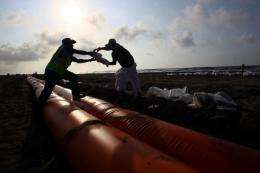Dispersants: lesser evil against oil spill or Gulf poison?

Nearly a million gallons of dispersant have been poured into the Gulf of Mexico to fight the largest oil spill in US history, even though little is known about their effects fishermen claim makes them sick and kills sea life.
At least nine fishermen idled by the spill during prime shrimping, oystering and fin-fishing season, were hospitalized last week after working to clean up the slick.
And seafood lovers turned out in the thousands last week for a seafood festival in Louisiana, fearing the oil and dispersant in peak spawning season had killed off this year's shrimp and oyster populations and the larvae of next year's harvests.
Clint Guidry, acting president of the Louisiana Shrimpers Association, has dubbed the Corexit dispersant being used as the Gulf's Agent Orange -- a herbicide used by the US military in the Vietnam war that has been shown to cause cancer, including leukemia; diabetes, heart disease and other illnesses.
When BP first began using dispersant in the Gulf of Mexico, it was an older version of Corexit, which contained the solvent 2-butoxyethanol, said Ron Tjeerdema, a professor of environmental toxicology at the University of California, Davis.
"That surprised me," Tjeerdema, who has studied dispersants for 25 years, told AFP.
"The reality is, they were trying to use up their old stocks of Corexit and then switched to the new ones, in which butoxyethanol is replaced by what they call a food-grade solvent," he said.
"They changed it for two reasons - to make it a little less harmful to workers and because the food-grade solvent is a little bit better at mixing with crude oil."
Studies by the US Centers for Disease Control and Prevention (CDC) link short and intermediate exposure to 2-butoxyethanol in monkeys, rats, mice, rabbits and dogs to several health conditions including the destruction of red blood cells, or hemolysis, which can lead to kidney, spleen or liver damage.
Other ill effects noted by the CDC were breathing difficulties, skin irritation, physical weakness and unsteadiness, sluggishness, and convulsions, as well as birth defects and fewer offspring in mammals.
The nine fishermen who took ill in the Gulf after helping to clean up the oil spill reported symptoms including chest pains, dizziness, nausea, and a burning sensation on the skin.
Louisiana tugboat captain Kevin "Godzilla" Curole used to surf off Port Fourchon, the Louisiana oil port closest to where the BP-leased Deepwater Horizon rig sank in April rupturing a riser pipe that has been spewing oil into the water ever since.
"I loved surfing there. It was my way of unwinding with my buddies," he told AFP.
"But the last time I went, on Mother's Day in early May, I couldn't wait to get out of the water and get home and have a shower. My skin was burning, my lips felt like they would fall off," he told AFP, blaming the uncomfortable sensation on BP's use of Corexit.
Last week, as Coast Guard Admiral Thad Allen said nearly a million gallons of dispersant had been used, Tjeerdema and some 50 other experts met for two days in Louisiana and unanimously recommended that dispersants still be used to fight the slick.
"We all agreed -- and we're talking 50 people -- that dispersants were the lesser of two negative possibilities, of two bad choices," Tjeerdema told AFP.
Essentially, the experts decided to sacrifice marine life -- which would be harmed anyway by the oil gushing into the Gulf and hanging underwater in huge plumes -- to protect the shoreline, including Louisiana's marshlands, home to numerous species of animals and plants.
Carys Mitchelmore explained in testimony to Congress last month the trade-off that is made when a decision is taken to use dispersant.
"This is an example of a known pollutant... purposely added to the marine environment," she said.
"It is used because its overall benefit to the environment offsets the risk.
"But it is an environmental trade-off, the protection of one habitat at the cost of another," she said.
Dispersants don't remove oil from the sea, but only change its properties, said Mitchelmore, adding that little was known about the toxicity of dispersants and dispersed oil.
She urged long-term monitoring of the use of dispersants.
(c) 2010 AFP




















